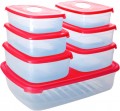Containers per set
The total number of individual containers supplied in the set (see "Type").
The more containers, the greater their diversity and the wider the choice of the user. At the same time, the variety can be not only in terms of volume, but also in proportions, and even in shape: for example, in sets of 5 items or more, there can be “high” and “low” containers, square containers can be combined with round ones, etc. .P.
It is worth remembering that “a lot” does not always mean “good”: an extensive set may require a lot of space, and it will cost accordingly. Therefore, when choosing, it is worth considering the real needs.
Min. capacity
The volume of the smallest container included in the set (see "Type"). In fact, there are quite a few situations when you need to pack a small amount of food, and a large container is not required. On the other hand, if the set is planned to be used regularly for numerous products, then perhaps the smallest tray should be quite large. See "Maximum Volume" for details on specific volumes.
Max. capacity
The largest volume of the container supplied with the kit. For sets (see "Type") in this case, the capacity of the largest container is indicated, for all other types — the actual nominal volume. Useful volume may be somewhat less, because. not all containers and not in all cases can be stuffed “under the very lid”. However, this difference is small, and this figure characterizes the capacity of the product well.
Estimating the amount of food that can fit inside, we can proceed from the fact that 1 liter of volume approximately corresponds to 1 – 1.2 kg of soup or a tightly packed product (for example, mashed potatoes) or 700 – 800 g of food, divided into pieces and not packed very tightly (for example, fried potatoes or salad). A large container takes up more space, and too little food can hang around inside, which usually does not contribute to safety. Therefore, too large a volume is just as undesirable as too small.
Dimensions (HxWxD)
Container dimensions in height, width and depth; for round containers (see "Shape") after the height, only one size is indicated — the diameter. Information about the dimensions allows you to evaluate the proportions of the container (in models of the same volume, they may be different) and determine what specific space it will need.
Max. temperature
The maximum temperature that the container can safely endure. Note that overheating the container can lead not only to its damage, but, in some cases, also to the release of harmful substances. Therefore, in no case should the claimed temperature be exceeded — even if the container remains intact, this does not mean that everything is fine.
The most delicate modern food containers have a maximum limit of 35 – 40 °C — this allows them to be used only for unheated food. Values of 70 °C are already found even among models compatible with microwave ovens, although for maximum guarantee it is desirable that the allowable temperature be at least 100 °C. And the most heat-resistant products (usually heat-resistant glass) can withstand temperatures up to 300 – 400 °C and can even be used for baking in the oven (although this heat resistance usually does not apply to lids, and they must be removed).
Country of origin
Country of origin of the brand under which food containers are marketed. Usually, it is indicated by the "homeland" of the manufacturing company or by the location of its headquarters.
There are many stereotypes associated with the “nationality” of brands and products, but most of them have no basis nowadays. First, the actual place of production is often different from the brand's country of origin. Secondly, the quality of the goods depends not so much on geography, but on the policy of a particular company and how carefully this very quality is controlled in it. Therefore, you should pay attention to the country of origin of the brand only if you fundamentally want or (do not want) to support a manufacturer from a certain state. Quality is best judged by the reputation of a particular brand and the general price category.

